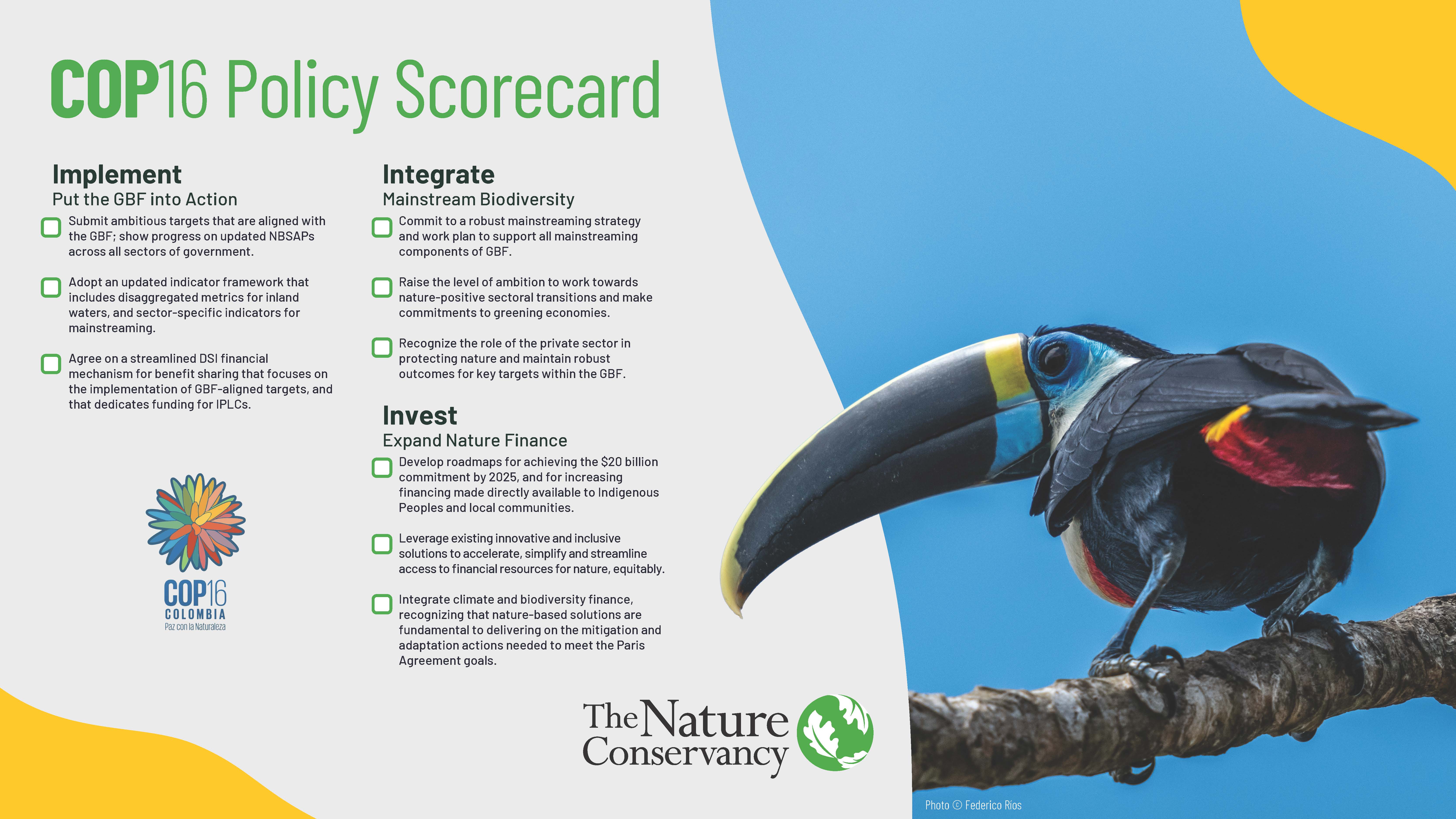TNC's Closing Statement
“Peace with Nature? Calí’s COP saw bright spots in battle for biodiversity, but momentum cannot be stalled by suspension”
Following the suspension of convenings at CBD-COP16, The Nature Conservancy's delegation lead Linda Krueger summarizes priorities moving forward
Biodiversity is the bedrock of life on Earth, underpinning our global economy, combating climate change, and sustaining the food systems that nourish the world.
Yet, we are witnessing an unprecedented crisis: habitats are vanishing, and up to a million species face extinction, threatening the lives and livelihoods of the billions of people who depend on them.
This is the reality as delegates from around the world met for the 16th meeting of the Conference of the Parties to the United Nations Convention on Biological Diversity (CBD COP16) in Cali, Colombia, October 21-November 1, 2024.
Let’s Make Breakthroughs Break Through
Get our monthly newsletter and join a community of changemakers.
The significant policy achievements made at COP16 in Cali, Colombia represent hopeful wins for nature. Although COP16 may not have finished as we'd hoped, we are encouraged to mark some very important milestones that resulted from this biodiversity conference which will have a significant impact on how the world advances nature-positive actions.
Achievements from Parties at CBD COP-16
- Overall 119 countries, representing 61% of Parties, submitted national biodiversity targets – policy measures and actions to help meet the targets of the GBF.
- In addition, to date 44 countries have submitted National Biodiversity Strategy and Action Plans (NBSAPs_ as the policy document which will support the implementation of these national targets. This indicates that even in turbulent times, governments are still treating nature loss with increasing seriousness.
- Subsidiary Body on Article 8(j): In a landmark decision at COP 16, Parties adopted a new Program of Work that sets out specific tasks to ensure the meaningful contribution of indigenous peoples and local communities towards the conservation of biodiversity and the implementation of the GBF. Through this Program, rights, contributions and traditional knowledge of indigenous peoples and local communities are further embedded in the global agenda.
- EBSA Breakthrough: COP 16 agreed on a new process to identify ecologically or biologically significant marine areas (EBSAs). Parties agreed on mechanisms to identify new EBSAs and update existing ones, ensuring that the cataloging of information of these areas can support planning and management with the most advanced science and knowledge available.
- Cali Fund: Parties established a new financial mechanism, the “Cali Fund”, for sharing benefits from Digital Sequence Information (DSI), which is an important move to address how pharmaceutical, biotechnology, animal and plant breeding and other industries benefiting from DSI should share those benefits with developing countries and Indigenous Peoples and local communities, ensuring at least 50% of funds dedicated to Indigenous People and local communities.
- GBFF Funding: An additional $163 million was pledged to the Global Biodiversity Framework Fund (GBFF), bringing total funding to around $396 million. The GBFF is funded by governments, the private sector, and philanthropies, and finances high-impact projects in developing regions, with emphasis on supporting countries with fragile ecosystems, such as small island states and economies in transition.
TNC also made news while at COP-16 on key areas of work aimed at accelerating conservation:
- Mainstreaming Champions Group of Parties: Eighteen governments launched a champions group to drive embedding the targets, goals, and principles of the GBF across all sectors of the global economy.
- Debt for Nature Coalition: Six global environmental organizations launched the Debt for Nature Coaltion to scale climate and conservation outcomes through sovereign debt conversions and tools like TNC’s Nature Bonds projects, unlocking billions for nature.
- Collaboration with France: Announcement of a transformative collaboration to help Gabon conserve 30% of its ecosystems by 2030, unlocking $60 million.
- Biodiversity Finance Dashboard: Release of the 2024 Biodiversity Finance Dashboard, highlighting the urgent need to mobilize increased finance for nature.
Our partnerships and collaborations with other organizations, governments, and local communities coming out of this biodiversity conference were crucial for achieving our conservation goals. Across all of Cali, the vibrant public engagement and variety of events, art, music, and conversations brought the call to action for biodiversity closer to a global audience.
Biodiversity and COP16 Resources
-

Nature Bonds Toolkit
A step-by-step guide designed for governments, partners, and other stakeholders seeking a thorough understanding of the process, best practices, and crucial considerations for world-class impact. Download the Toolkit
-

Enduring Earth
Protecting 30% of the Earth's land and water by 2030. See how we attain an enduring Earth
-
Target 3 of the Global Biodiversity Framework—30x30
Our future depends on protecting 30% of the planet’s oceans, lands, and freshwaters by 2030 in the biggest conservation commitment the world has ever seen. See how we can achieve 30x30
-

TNC's COP16 Policy Scorecard
Here are the outcomes that TNC is advocating at Biodiversity COP16 in Cali: Implement the GBF into action. Integrate mainstream biodiversity. And Invest, expand nature finance. Download the Scorecard

Colombia: A haven for biodiversity
Hosting COP16 in Colombia emphasizes the strategic importance and natural wealth of the country. With more than 67,000 species of plants and animals, Colombia is the third most biodiverse country in the world.
Yet many of Colombia’s most biodiverse regions lack formal protections or are at risk from climate change. TNC has been working with local partners to protect Colombia’s iconic landscape, including by creating the Natural National Park Serranía de Manacacías, which covers 68,000 hectares and connects the Amazon rainforest with the Orinoquia, the world’s largest tropical savanna.
Home to 40% of the world's existing species, the second longest barrier reef, and more than 1/3 of freshwater resources, including the Amazon and Orinoco basins, the two most biodiverse on the planet, Latin America is a vital source of the world’s natural resources. But it also faces great challenges to halt the loss of biodiversity and face the impacts of the climate change crisis. Learn more about TNC’s work in this treasured part of the world.




